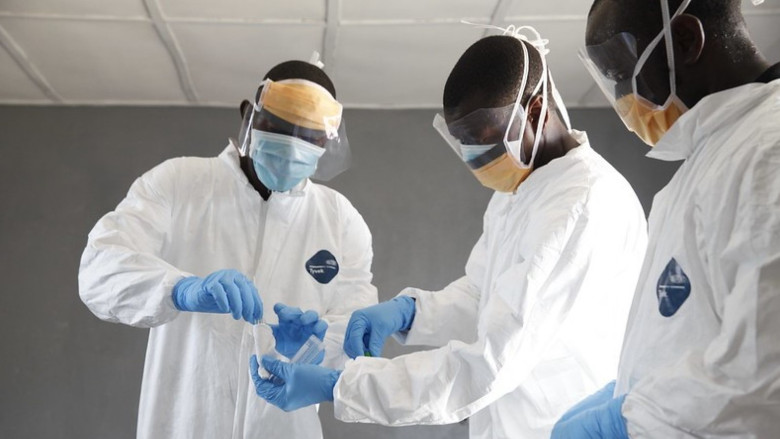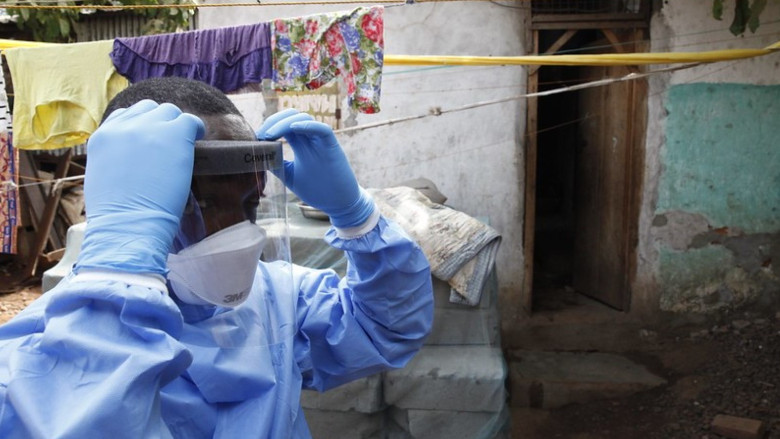Challenge
The 2014–2016 Ebola outbreak in West Africa dramatically exposed the need for more resilient health systems, multi-sector engagement, and collaboration among neighboring countries to prevent, detect, and respond to the threat of emerging and epidemic-prone diseases. The Ebola outbreak overwhelmed the public health systems in Guinea, Liberia, and Sierra Leone, allowing for rapid escalation and geographic spread of the outbreak as well as the disruption of essential and life-saving health services during the emergency. The World Bank launched the Regional Disease Surveillance Systems Enhancement (REDISSE) Program in 2016 to respond to the challenge and help protect countries from epidemic threats due to Ebola and other pathogens such as COVID-19.
Approach
The REDISSE Program is an interdependent series of projects developed between 2016 and 2019. At present, 16 countries in West and Central Africa participate in the program, which works on three fronts: addressing weaknesses in human and animal health systems for disease surveillance and response, building capacity for effective cross-sectoral and cross-border collaboration, and providing an immediate and effective response to emergencies.
REDISSE activities directly benefit almost half a billion people living in some of the most vulnerable countries in the world. REDISSE is financed by a combination of International Development Association (IDA) credits and grants, International Bank for Reconstruction and Development (IBRD) loans ($60 million for Angola), and multi and single-donor trust funds. It allows IDA-eligible countries to access both country and regional IDA financing, which incentivizes countries to invest in modern disease surveillance systems, laboratory capacity, the health security workforce, and outbreak planning and readiness.
The regional approach championed by REDISSE emphasizes collective action and cross-border collaboration that promotes information sharing, harmonization of policies and procedures, and joint planning, implementation, and evaluation of program activities. It also calls for sharing high-cost specialized assets, such as regional reference laboratories, training institutions, and emergency stockpiles. Given the importance of the human-animal-ecosystem interface in the emergence and spread of new and epidemic-prone diseases, REDISSE upholds an inter-disciplinary “One Health” approach that fosters activities and collaboration among multiple sectors. REDISSE is a learning program and has benefitted from the integration of lessons learned during implementation through restructuring as well as more formal analytic work.

Results
REDISSE is comprised of four regional projects with a total of 16 participating countries and two regional institutions in West and Central Africa. All REDISSE projects contribute to regional health security and national capacity to prevent, detect, and respond to disease outbreaks and epidemic.
REDISSE has advanced health security in West Africa and is poised to make an impact in Central Africa. At the regional level in West Africa, REDISSE contributions include the following:
Inter-country agreements on policies, strategies, and protocols were established for laboratory standards (2017); biological specimen transport (2018); and regional policies on implementation, biosafety, bioinformatics and biosecurity (2019).
A One Health platform to promote intersectoral collaboration was established and a One Health implementation roadmap was adopted by Ministers of Health, Agriculture/Livestock and the Environment in 2017.
A regional network of 15 regional reference laboratories for human and animal health was established in October 2016.
An Advanced Field Epidemiology and Laboratory Training Program was established in 2018, and over 100 students are receiving masters-level training at regional institutions. The first cohort of 50 students will graduate in 2020.
Forty-seven (of a planned 147) district-level Centers for Epidemiologic Surveillance (CES) were established between 2017 and 2019. Fifty-three additional CES are under development.
A regional network of biobanks and a regional stockpile for personal protective equipment, drugs, and vaccines for epidemic response in Cote d’Ivoire were established in 2018.
REDISSE has also strengthened surveillance and response systems in participating countries. The three countries that have been in the program the longest (Guinea, Senegal, and Sierra Leone) report substantive progress between 2017 and 2019 on several key project indicators.
REDISSE countries are:
Integrating and modernizing their disease surveillance systems
Building laboratory diagnostic and research capacity
Establishing a resilient health security workforce
Putting systems in place for emergency response
Strengthening national public health institutions
Responding to real-time public health emergencies, including COVID-19
REDISSE provided participating countries with early and immediate access to World Bank financing for COVID-19 preparedness and response, while complementary country-specific financing was mobilized from the World Bank’s COVID-19 Fast-Track Facility. REDISSE is presently supporting:
COVID-19 surveillance
Screening at points of entry
Laboratory testing and diagnosis
Infection prevention and control
Case management, including essential medical equipment and materials
Risk communication
Bank Group Contribution
The Bank contribution to REDISSE is $657 million, of which $597 million is a mixture of IDA grants and credits and $60 million is from IBRD. Since February 2020, approximately one third of the Bank contribution ($210 million) has been allocated to the COVID-19 response. In addition, the program has benefitted from $9.95 million in Bank-executed trust funds and $13.13 million in recipient-executed trust funds for regional activities managed by the West African Health Organization (WAHO).
Partners
Financing and technical partners include the Bill and Melinda Gates Foundation ($0.96 million), the United States Centers for Disease Control and Prevention, the Connecting Organizations for Regional Disease Surveillance Network, Global Affairs Canada ($13.13 million to establish 147 CES), Resolve to Save Lives ($2.16 million), the People’s Republic of China ($0.75 million for Sierra Leone), and the Ebola Emergency Response Trust Fund (Russia, UK, Norway, The Netherlands, Denmark and Japan).
The implementation partners that receive regional IDA grants are WAHO ($20 million IDA + $13.13 million) and the Economic Community of Central African States ($10 million). They coordinate the program and manage sub-contracts with the Universities of Ghana and Ouagadougou (advanced training in the field of Epidemiology), the World Organization for Animal Health and the Regional Animal Health Centers in Bamako and Ndjamena (One Health), the Center for International Cooperation in Health and Development and Fondation Merieux (CES and laboratory capacity), and the World Health Organization (WHO) Regional Office for Africa (program monitoring and evaluation).
The REDISSE Program also promotes information exchange and collaboration with other donor partners contributing to the health security agenda in the region, including the United States Agency for International Development (USAID), The Deutsche Gesellschaft für Internationale Zusammenarbeit (GIZ), Public Health England, and the Japanese International Cooperation Agency (JICA).
Moving Forward
REDISSE is still in the early stages of implementation; however, the rapid depletion of REDISSE funds for the COVID-19 response threatens the continuation of careful and deliberate investment in surveillance and response systems and achievement of the project development objectives in the medium term. Countries participating in REDISSE are seeking additional financing, and the demand for World Bank investments in “REDISSE-like” operations are expected to rise in Africa and other regions. In fiscal year 2021, the REDISSE task team will facilitate project replenishment and restructuring as required, incorporating lessons learned in both routine implementation and response to the COVID-19 crisis. In addition, operational research into the gender dimensions of health security and epidemic response is being initiated to improve the implementation model of REDISSE and inform future investment in health security.
Beneficiaries
Nearly half a billion people in West and Central Africa are benefitting from REDISSE. It strengthens both national and regional institutions to prevent, detect, and effectively respond to disease threats in both human and animal population. For example, laboratories have been able to expand and strengthen testing, quality control, biosafety, and biosecurity. According to Dr. Alpha Sall, Director General at the Institute Pasteur in Dakar, “We were able to enhance surveillance systems for all kinds of diseases across Senegal. The equipment provided will allow us to rapidly detect and improve our capacity to mobilize resources and respond to disease outbreaks like coronavirus.”
Since 2017, the World Bank has provided support to the Nigeria Centre for Disease Control (NCDC) to strengthen the country’s capacity to rapidly detect and respond to disease outbreaks to contain their impacts and prevent spread. According to Dr. Oladejo, Director for Health Emergency Preparedness and Response, NCDC, “When the COVID-19 virus was announced, we started a technical working group for preparedness. We had all partners involved and started preparing, looking at infrastructure, schedules of drugs, points of entries where suspected cases would most likely be coming from. Immediately, we had the first suspected case in February, and we quickly started the Emergency Operations Centre. We finalized our Incident Action Plan and followed it strictly to ensure we didn’t leave any stone unturned. The World Bank, UNICEF, WHO, and the NCDC all worked as one to pull this off,” he said.
